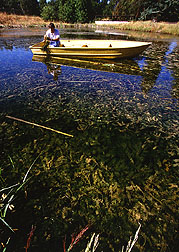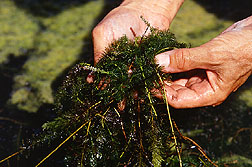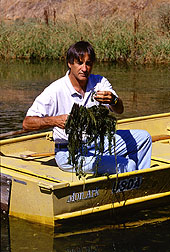Foiling Watermilfoil
In aquatic weed known as Eurasian watermilfoil—and its rascally cousin parrotfeather—can quickly take over lakes, rivers, irrigation canals, farm ponds, and other watery habitats. They crowd out desirable native vegetation, clog irrigation systems, and make waterways unsuitable or unpleasant for boating, fishing, and swimming.
Native to Europe and Asia, Eurasian watermilfoil, Myriophyllum spicatum, has been found throughout the United States. Parrotfeather, Myriophyllum aquaticum, an escaped South American species, is less pervasive in the United States than Eurasian watermilfoil. However, parrotfeather forms denser stands that make ideal breeding grounds for mosquitoes.
At Davis, California, ARS plant physiologist Lars W.J. Anderson and colleagues in the agency's Exotic and Invasive Weed Research Unit are seeking new ways to control the two weeds. Working with scientists at the University of California, Davis, they've shown for the first time that a widely used aquatic herbicide—applied to above-water shoots of parrotfeather—may appear effective at first, but does little to knock out the extensive underwater growth of the weed.
A better tactic for the future may be to apply the herbicide triclopyr below the water surface. The ARS scientists were the first to test this chemical on parrotfeather. They conducted the experiment at a 20-acre lake in the oak woodlands of Beale Air Force Base in northern California. The lake has been infested with this weed for about 20 years.
|
|
Anderson did the work under terms of an experimental use permit from the U.S. Environmental Protection Agency. He collaborated with resource managers at the base and with Dow AgroSciences LLC, which markets the herbicide as Garlon 3A for use in other ecosystems. So far, according to Anderson, triclopyr worked better than any other option tested at the lake.
Anderson and co-researchers are also conducting sophisticated laboratory analyses of the two milfoils to precisely identify differences in the genetic makeup of these weeds from different sites. That approach could boost the success of biological control insects such as the watermilfoil weevil, Euhrychiopsis lecontei.
For best results, weevils recruited to stop the spread of the weeds should be matched as closely as possible to Eurasian watermilfoil plants most genetically similar to those from which the insect was collected. University scientists in Vermont and Minnesota have already conducted some biological control tests with this little brownish-black insect.
Other ARS investigations have revealed differences in the chemical makeup of Eurasian watermilfoil. Those differences might affect the plant's nutritional value to the weevil—and thus the weevil's vigor, according to ARS ecologist David F. Spencer at Davis. Nitrogen in Eurasian watermilfoil plants sampled from the Truckee River in California, for instance, was "lower than the nitrogen content in plants sampled from a shallow research pond at the Davis lab," says Spencer.
|
|
"Studies done by ARS scientists in Florida," he notes, "showed that the relative growth rate of a weevil that eats a water weed called hydrilla increased by 50 percent when the weevil was fed plant material with 3.5 percent nitrogen, as compared to plant material with only 2 percent nitrogen."
Based on those results, differences in nitrogen in Eurasian watermilfoil plants from various sites might also make a difference in how fast the helpful weevils develop—and how effectively they foil these notorious weeds.—By Marcia Wood, Agricultural Research Service Information Staff.
This research is part of Crop and Commodity Pest Biology, Control, and Quarantine, an ARS National Program described on the World Wide Web at http://www.nps.ars.usda.gov/programs/cppvs.htm.
Lars W.J. Anderson and David F. Spencer are in the USDA-ARS Exotic and Invasive Weed Research Unit, c/o UC Davis, One Shields Ave., Davis, CA 95616; phone (530) 752-6260 [Anderson], (530) 752-1096 [Spencer)], fax (530) 752-4604.
"Foiling Watermilfoil" was published in the March 1999 issue of Agricultural Research magazine.









